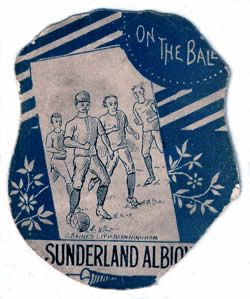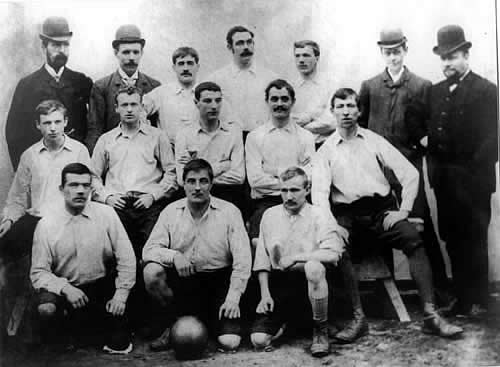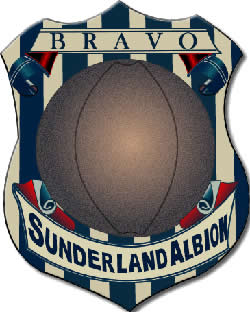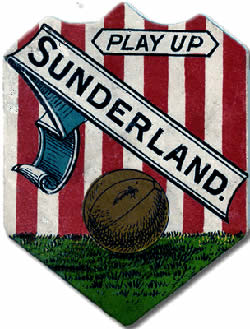sunderland albion
13 March 1888 to 9 august 1892
Introduction In December 1887 Sunderland defeated Middlesbrough in an FA Cup tie. However Sunderland were subsequently disqualified from the rest of the tournament after it was revealed they had played ineligible professional players; Monaghan, Richardson and Hastings, who had been “imported” from Dumfries for the match.
The Middlesbrough debacle alluded to above has always been identified as a main reason for Allan leaving the Committee i.e. Allan and others had a general dissatisfaction about the direction in which the club was heading. Another factor cited for Allan leaving Sunderland AFC was a potential move away from Newcastle Road and problems with the lease that was due to expire on 13 May 1888. The annual meeting of the Sunderland Association Football Club was held on the 3rd May 1888 in the Monkwearmouth Workman’s Hall with Club President Councillor Robert Thompson occupying the chair. James Allan was identified as being the Sunderland AFC Treasurer, although at this meeting Mr. Samuel Tyzack of the Monkwearmouth Ironworks was appointed Treasurer in place of Mr. James Allan, in effect ousting or replacing (depends on what stance you take) the SAFC’s founder. Note that there is no mention of Allan volunteering to leave SAFC nor of Sunderland AFC giving James Allan a vote of thanks for all he had done for SAFC (including remember, founding the club), nor of the founding of Sunderland Albion. It can only be presumed that James Allan, as appointed SAFC Treasurer, was under an obligation to attend and present his figures. Not only that but as he had formed Albion less than 2 months previously its fair to assume that there could have been bad feeling even at that early stage of the rivalry, hence no thanks for Allan, who then became the first Secretary and Treasurer of the Sunderland Albion Club. Albion would use Sunderland AFC’s old Blue House Field ground for fixtures and the HQ for Albion would be at the Waverley Hotel in Norman Street, Hendon. Big business had now taken over Sunderland AFC, but Albion were determined to make a name for themselves. Sunderland AFC’s main problem at this time was how to fill a void left by the departure of 7 players. Albion’s first fixture was on 5 May 1888 against Shankhouse Blackwatch (which is 9 miles North of Newcastle). This was a mere 48 hours after the 3 May 1888 meeting had finished. Albion’s first lineup for the game at the Ashville Ground was as follows: Stewart, Oliver, Gilmartin, Richardson, Moore, Baxter, Scott, Kilpatrick, Melville, Monaghan and Nugent. Albion led 2 v 0 at half time and triumphed 3 v 0. Five of the Albion players were “imported” from Newcastle Club, Elswick Rangers, especially for the game. _____________________________ 1887/88
Sunderland Albion were now backed by some wealthy individuals, most noticeably James Hartley, who along with his brother John owned the Wear Glass Works at Monkwearmouth, founded in 1837. The backing arose from James Allan’s friendship with Hartley; they were neighbours, Allan living nearby in Whitehall Terrace. Furthermore there is evidence to suggest that Albion were also backed by wealthy brewers and players such as James Hannah, for example, became landlord of the Free Gardeners Arms in Williamson Terrace. What is interesting to note is that Sunderland AFC had given notice to quit the Newcastle Road ground in November 1887. Whilst no firm date was given for the move Sunderland would stay on at that venue until 1898. There could well be a reason why Sunderland AFC stayed so long at Newcastle Road, or certainly for as long as Albion remained in existence, as we shall read shortly. _____________________________ 1888/89 In September 1888 Allan’s professional career changed as he moved from his teaching position at Thomas Street School to become the Headmaster at Hylton Road School on the South side of the River.
 Sunderland Albion started off the season with 4 teams – Sunderland Albion, Albion Reserves and 2 Swift Teams. For the Reserves it was a successful season as they defeated Herbert Rangers in the Sports Senior Cup Final on 25 May 1889. A 5th team existed, in theory, as the Albion Committee played a Charity Match against Sunderland Liberal Association on 27 March 1889. Sunderland Albion started off the season with 4 teams – Sunderland Albion, Albion Reserves and 2 Swift Teams. For the Reserves it was a successful season as they defeated Herbert Rangers in the Sports Senior Cup Final on 25 May 1889. A 5th team existed, in theory, as the Albion Committee played a Charity Match against Sunderland Liberal Association on 27 March 1889.
Albion’s first team, like Sunderland’s played a succession of friendly games in 1888/89, however the club’s should have met 4 times during the season but actually played each other just twice. Here’s how it went. 1 December 1888: Sunderland and Sunderland Albion were drawn to play each other, as fate would have it, in the second round of the Durham Challenge Cup. Sunderland simply refused to play. The reason behind the walkover given to Albion was simple – Sunderland didn’t want to give Albion any money and as a meeting between the 2 sides was the most eagerly awaited contest in the Town it would have drawn a massive crowd and made the Albion coffers swell, an unattractive proposition to Sunderland. 18 December 1888: Yet again both teams drew each other in a cup competition, this time the FA Cup 4th Qualifying round. Again Sunderland refused to play. Not only was this about starving Albion of much needed funds but it also meant that it scuppered Albion’s plans to take the gate receipts, buy the Blue House Field, fence it off and charge a “gate”. Sunderland could just about stomach the fact that everyone watched Albion’s games for nothing. Coming back to the Newcastle Road story, it could be that one of the reasons that Sunderland moved later than intended and were desperate to stay at the venue was that if they had left whilst Albion were in existence then the latter could have taken up tenancy at Newcastle Road, charged a gate and been a real threat to SAFC. However, such was the outcry about Sunderland refusing to meet Albion that eventually they had to relent. However in agreeing to face them at Newcastle Road there would be a twist in the tale. Sunderland suggested that apart from £20 in expenses, both clubs should give the proceeds to Charity. Albion said no, but the match still went ahead. The match took place on the date of the original Durham Challenge Cup fixture 1 December 1888. A further factor in Sunderland not wishing to play Albion in a cup game was the fact that their Scottish players would have been ineligible and so they would have risked defeat by their junior neighbours. This wasn’t palatable to the Sunderland Committee. In advance of the 1 December game James Allan wrote to the Sunderland Secretary Mr. Wallace asking about ticket arrangements for the fixture - Sunderland 2 v 0 Sunderland Albion - 1 December 1888 Afterwards Albion once more pressed for a friendly match and once more Sunderland agreed, but only on the same conditions as before – the money went to Charity. This time Albion agreed and a local Councillor put up a trophy for the winners. If we didn’t know it before the match, we would know it after – both clubs felt threatened by the other, and in what was to become one the most infamous games in the history of Sunderland AFC this encounter summed up what the relationship between the 2 clubs was all about. Tensions ran high prior to the encounter: _____________________________ Tuesday 8 January 1889 Now I come to the big match. Many thousands have been “a’ wearin’ for the twelt” and they will not have to wait much longer. The proceeds of the encounter are to be divided among our local charities. It is proposed to allot £10 to the eye Infirmary, £10 to the children’s Hospital and the remainder to be divided between the Sunderland Infirmary and the Monkwearmouth Dispensary. The interest taken in this match, perhaps not so great as in the previous meeting between the clubs, is very great, and there is every probability of the crowd being quite as large as on that occasion. An attempt was made to get the match played off at Ashbrooke but without success and the Newcastle Road ground will again be the scene of the contest. Great care will be exercised in the selection of the teams and each side will be represented as strongly as possible, barring accidents. The lists of players are not ready yet, but I expect the Sunderland team will be the same as played on Saturday last with the alteration that Breconridge will be found in his old place as centre forward. In the Albion team I expect we shall see Moore and MacFarlane at back; Munro at centre half and the wings the same as played last week. I hear that a new centre forward will make his first appearance in the Albion ranks on the great day. There has been some soreness felt owing to the bills of the Bolton Wanderers, giving a record of their performance being defaced and in some cases destroyed. The Police were put on the lookout and as a result three mischievous boys were caught in the act on Saturday and 2 of them will doubtless appear before their betters to answer for their conduct. The Sunderland committee have no knowledge of the matter and it is quite evident that the soreness has been occasioned over the acts of some half a dozen boys. I have received a circular particularly requesting that the Albion supporters should line the filed outside the ropes, so that the Albion players may see friendly faces and not a hostile crowd. I am glad to intimate that the Albion Secretary disavows the authenticity of the circular and sets it down to some enterprising individual. The Sunderland committee at their meeting last night also (unnecessarily I think) disclaimed any knowledge of the circular. I do not propose to discuss it further. Before going onto other matters I would earnestly impress upon those that intend to see the game to do all they can to preserve order. There is no reason why there should not be a rivalry between the clubs, so long as it is a friendly one and the spectators have a great deal to do with the spirit in which the game is regarded. A good tempered, fair and impartial crowd – such as was seen at the last match – is what is wanted and I hope that such will be present on Saturday. Sunderland 3 v 2 Sunderland Albion - 12 January 1889 The unfortunate way in which the game ended was deeply regrettable and will only serve to widen the already considerable breach between the two Sunderland clubs. The referee commented that he was quite certain the disputed 3rd goal was legitimate. He said that Albion custodian Angus had fisted the ball out and after striking Breconridge on the cheek it had shot upwards and went just under the bar although to those some distance away it may have looked as if it had gone over. However many of those close to the goal also thought the ball went over the bar as did Angus and most of the Albion team. Mr Stacey is well known for his impartiality and so there the matter must rest and it would have been more sportsmanlike for the Albion players to accept his decision and continue the game. By walking off they lost a great deal of sympathy. Regrettably this was manifest in unpleasant scenes as the Albion team left the ground in their brake for the Waverley Hotel. They were followed by a howling crowd and several stones were thrown with 3 or 4 of the Albion players being hit. J.Stewart was struck on the forehead and their umpire Mr Allan was hit in the corner of his eye. He was taken to Mr Davis surgery to have his wound attended to. On arrival at the Waverley Hotel several players were interviewed Angus in particular. In reply to questions he said that on approaching the referee and asking if he intended awarding the 3rd goal Mr Stacey replied “Yes I think that the ball went under the bar.” Mr Angus is adamant that the ball went at least 2 feet over the bar. The Albion players were unanimous in saying they will not play at Newcastle Road again but would meet Sunderland at a neutral venue. They were loud in their denunciations of the treatment they received at the hands of the crowd. The Albion committee issued the following statement later: “After the match about 50 spectators who had been standing either behind the Albion goal or were in line with the goalposts came forward and gave their names to the committee. They all stated that the 3rd goal claimed by Sunderland was invalid since the ball went 2 feet over the bar. During the evening the referee Mr Stacey called at the Albion headquarters in the Waverley Hotel before he left town to express his regrets that the incident should have occurred. He said that he had a difficult task to perform owing to the intense excitement of the spectators and had witnessed nothing like it elsewhere. If he had made a mistake then he was sorry. This incident has soured the already poor relations between the clubs and it is to be hoped that it may now be put behind them. On a more positive note the gate receipts amounted to £167-8s-0d made up of Boys £20-7s-8d, reserved seats £76-6s-5d, three penny stands £70-13s-11d. In the evening the Sunderland team were entertained to dinner at the Queens Hotel where the 5 guinea silver cup, presented by Councillor Roger Errington was handed to the winners. _____________________________ The rivalry between the 2 clubs was now at its most intense and as we can tell it was a very bitter occasion that saw the Albion team walk off the field and also saw their Brake stoned on the way from Newcastle Road into the Town. Several Albion players were injured and the Police spoke with the teams after the game to get evidence that could be used as part of any criminal prosecution. James Allan was hit in the face by a projectile and needed medical treatment, ironic when you consider who the match was played for the benefit of. The fallout from the match would last until the next month when an inquiry would be held. _____________________________ 1889/90

Sunderland Albion 3 v 0 Derby Junction - 14 September 1889 Back Row – left to right – Allison (Committee), Campbell (Trainer), McDermid, Angus, McFarlene, Coates (Secretary), Glass (Vice Chairman) Middle Row – Hannah, White, McNichol, Stewart, Brand Front Row – Smith, Weir, Kinnaird The Football League had been formed for the 1888/89 season with an original 12 members. In order to establish who would compete for the 1889/90 league championship the bottom 4 teams had to re-apply for election. Stoke (10 votes), Burnley (9), Derby County (8) and Notts County with 7 votes, duly made it an unchanged line-up. Mitchell St George’s (5), Sheffield Wednesday (4), Bootle (2), Sunderland (2), Newton Heath (1), Grimsby, South Shore, Sunderland Albion and Nelson with not a solitary vote missed out. Sunderland Albion therefore became a founder member of the Football Alliance, whilst Sunderland AFC continued to play a series of friendly games. Both clubs took part in both the Durham Challenge Cup and FA Cup. Albion’s 1889/90 Football Alliance campaign was not without incident as their opening match at Darwen had to be replayed. It didn’t get much better in the FA Cup when Albion were disqualified after they fielded McKetchnie who was also registered in Scotland with Glasgow Port Vale. It got even worse when Albion were suspended for 2 weeks, from 10 February 1890, for paying travelling expenses to one of their players (not allowed). With Bishop Auckland refusing to change the 22 February Durham Challenge Cup game, Albion were therefore disqualified from the competition. Albion’s 2 v 0 victory against Birmingham St George’s on 7 April 1890 was expunged from the record books and the match was ordered to be replayed. The Midlands team refused and so the 2 points were awarded to Sunderland Albion. Following the end of the season, Long Eaton Rangers dropped out and went into the Midland League. Stoke City came into the Northern Alliance for the 1890/91 season; with their place in the Football League being taken, of course, by Sunderland AFC. In March 1890 Sunderland Albion Football & Athletic Company Limited was formed with capital of £3,000. Furthermore the Blue House Field ground was expanded and now featured a cycle track. Allan was confident of entry into the Football League and the club readied itself for this. Sunderland’s application to join the Football League for the 1890/91 season was successful and was a bitter blow to Albion’s hopes of eclipsing the Town’s oldest club. In response Albion decided to play in 2 leagues for 1890/91; the Football Alliance again and the Northern League. _____________________________
|

 On Tuesday 13 March 1888 Allan held a meeting at The Empress Hotel in Union Street to form Sunderland Albion. Seven Sunderland players would defect to Albion along with Sunderland AFC’s first President, Alderman Potts. It’s likely that the latter would have gone anyway when less than 2 months later the Committee of Sunderland AFC was reduced from 30 to 15 members.
On Tuesday 13 March 1888 Allan held a meeting at The Empress Hotel in Union Street to form Sunderland Albion. Seven Sunderland players would defect to Albion along with Sunderland AFC’s first President, Alderman Potts. It’s likely that the latter would have gone anyway when less than 2 months later the Committee of Sunderland AFC was reduced from 30 to 15 members.  Following the Shankhouse Blackwatch game Albion defeated Newcastle West End. Whilst both victories were well merited and on face value surprising, given the infancy of Albion, it perhaps wasn’t such a shock bearing in mind that the Albion combination was really Sunderland AFC all but in name.
Following the Shankhouse Blackwatch game Albion defeated Newcastle West End. Whilst both victories were well merited and on face value surprising, given the infancy of Albion, it perhaps wasn’t such a shock bearing in mind that the Albion combination was really Sunderland AFC all but in name.